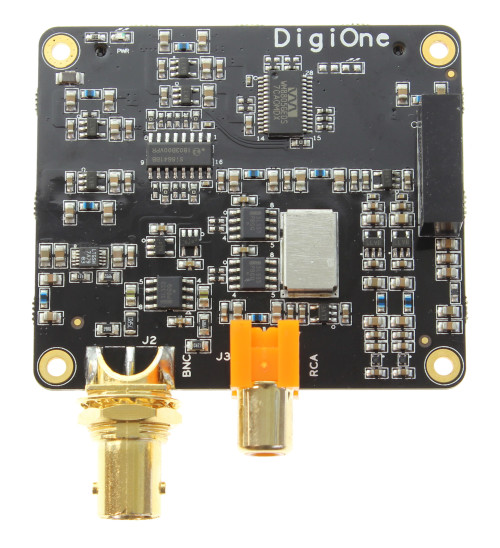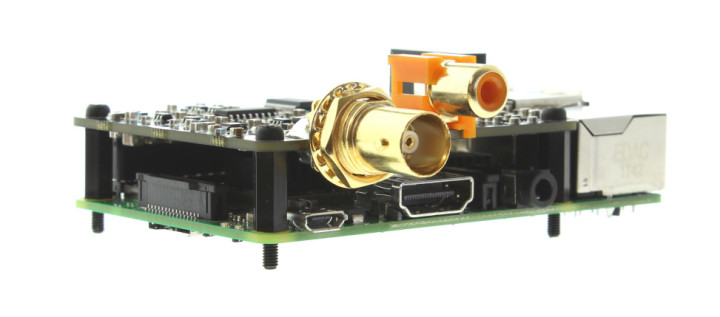Review: Allo DigiOne Audio HAT for RPi
on
 For the cost of 3 Raspberry Pis you will get from Allo, the DigiOne, a HAT (Hardware Attached on Top) for the Raspberry Pi, which makes available a digital S/P-DIF signal from the audio signal playing on the Pi. Why would you want to do that? Well, the DigiOne is intended, together with the Raspberry Pi, to function as a high-end transport – a device that transfers audio data from the storage medium (USB-stick, hard disk, NAS, internet stream, etc.) to the DAC.
For the cost of 3 Raspberry Pis you will get from Allo, the DigiOne, a HAT (Hardware Attached on Top) for the Raspberry Pi, which makes available a digital S/P-DIF signal from the audio signal playing on the Pi. Why would you want to do that? Well, the DigiOne is intended, together with the Raspberry Pi, to function as a high-end transport – a device that transfers audio data from the storage medium (USB-stick, hard disk, NAS, internet stream, etc.) to the DAC.If you take your sound quality seriously, then you won't use the digital stream available via the HDMI connector, and you certainly won't use the analogue output on the Pi itself! No, you will instead use the I²S output from the RPi that is available at the GPIO header, then isolate that from all the other electrical signals, generate a new clock signal and combine this with the digital audio signal, according to Allo. This is very effective for combating the jitter and noise in the digital signal. And that shows. With jitter of only 0.6 ps and noise of only 50 uV the DigiOne is justifiably a little bit proud. To give you an impression of the numbers: in 0.6 ps, light in vacuum travels a distance of only 0.18 mm!



The DigiOne presents the newly clocked S/P-DIF signal via a standard cinch socket and via a BNC socket (this therefore does not have the Wordclock signal). The optical Toslink interface has deliberately been omitted. This has, according to the engineers from Allo, simply too much of a problem with jitter. Although the importance of jitter can be debated extensively, considering that D/A converters ought to be able to cope with that to a certain extent, it is nevertheless a safe design decision.

The I²S signal enters, as already mentioned, via the GPIO connector of the RPi. As does the power supply. The latter is, via an isolated DC/DC converter with filters and LDO, stripped of the notoriously polluting interference that plagues the 5 V power supply of the Raspberry Pi. No less than 10 LDOs (“Low Drop Out” – voltage regulator with a very small minimum voltage drop between input and output) are used, among others the LT3042 from Linear Technology (the other could be the LP5907MFX-3.3 from Texas Instruments, on the assumption from reading the SMD marking “LLVB”). 12 low-pass filters help to suppress interference some more. The I²S signal too, is electrically isolated to eliminate interference. For the electrical isolation, the DigiOne uses a Si8641 from Silicon Labs.

The central component is the WM8805 S/P-DIF digital interface transceiver from Cirrus Logic. This can handle practically all the present-day digital audio sample rates and accepts the I²S data format. This chip converts the I²S signal into the S/P-DIF signal and so supplies a standard format for Hi-Fi equipment.

I have tested the DigiOne together with the Raspberry Pi 3B+ and Volumio 2.522, which to me, looks like a very appropriate combination. What does it sound like? Well, what can you say about that... Actually it doesn't sound at all! The DigiOne appears to be completely transparent and adds practically no sound of its own to the music. Pure sound therefore! It appears to exude both quiet as well as accurate liveliness when the music demands it. Clear, stable, not sharp, not dull or damped. Even on my – modest – DIY loudspeakers I hear a pleasant difference between the music played via the HDMI output from the Raspberry Pi and the DigiOne.
Is the DigiOne worth the three times higher pricetag of the Raspberry Pi? As far as I'm concerned, when you look at the entire package – that is, RPi+DigiOne – very much so! For give-or-take €150 (including enclosure) you will bring a top-class digital audio player into your house with a ton of features and with specifications that will intimidate many a high-end player. Of course, there are better options, but none that I have found at this price.




Discussion (0 comments)